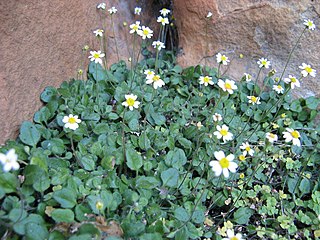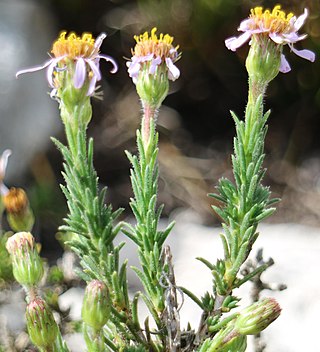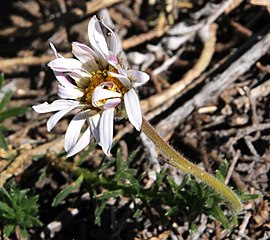
Felicia aethiopica is a low shrublet of up to about 50 cm high that is assigned to the family Asteraceae. It has rigid, leathery, inverted egg-shaped leaves, with only the lowest pair set oppositely. It has flower heads with an involucre of about 8 mm in diameter with bracts that each contain three resin ducts, and have one whorl of twelve to fourteen ray florets with about 11 mm long and 1½ mm wide blue straps surrounding many yellow disc florets. The plant is called wild aster or dwarf Felicia in English, and wilde-aster or bloublombossie in Afrikaans. Flowering occurs year-round. Wild aster can be found in the Western and Eastern Cape provinces of South Africa.

Felicia filifolia is a Southern African member of the family Asteraceae. It is a hardy, sprawling shrub growing to about 1 metre tall. Leaves are narrow and clustered along the twigs. When blooming it is densely covered in flowerheads with ray florets that are pink-mauve to white and disc florets that are yellow. In the wild, flowers can be found August to December.

Didelta is a genus of shrubs of up to 1 or 2 meter high, with two known species in the daisy family. Like in almost all Asteraceae, the individual flowers are 5-merous, small and clustered in typical heads, and are surrounded by an involucre, consisting of in this case two whorls of bracts, which are almost free from each other. The 3–5 outer bracts are protruding and triangular in shape, the inner about twice as many are lance-shaped and ascending. In Didelta, the centre of the head is taken by 3–5 clusters of bisexual yolk yellow disc florets, sometimes divided from each other by male disc florets, and is surrounded by one complete whorl of infertile yolk yellow ray florets. The common base of the flowerhead swells around the developing fruitlets, become woody and breaks into segments when ripe. The fruitlets germinate within this woody encasing. The species of the genus Didelta can be found in Namibia and South Africa. The genus is called salad thistle in English and slaaibos in Afrikaans.

Corymbium is a genus of flowering plants in the daisy family comprising nine species. It is the only genus in the subfamily Corymbioideae and the tribe Corymbieae. The species have leaves with parallel veins, strongly reminiscent of monocots, in a rosette and compounded inflorescences may be compact or loosely composed racemes, panicles or corymbs. Remarkable for species in the daisy family, each flower head contains just one, bisexual, mauve, pink or white disc floret within a sheath consisting of just two large involucral bracts. The species are all endemic to the Cape Floristic Region of South Africa, where they are known as plampers.

Gorteria diffusa is a highly variable, small annual herbaceous plant or rarely a shrublet that is assigned to the daisy family. Like in almost all Asteraceae, the individual flowers are 5-merous, small and clustered in typical heads, and are surrounded by an involucre, consisting of in this case several whorls of bracts, which are merged at their base. In G. diffusa, the centre of the head is taken by relatively few male and bisexual yellow to orange disc florets, and is surrounded by one complete whorl of 5–14 infertile cream to dark orange ray florets, sometimes with a few ray florets nearer to the centre. None, some or all of them may have darker spots at their base. The fruits remain attached to their common base when ripe, and it is the entire head that breaks free from the plant. One or few seeds germinate inside the flower head which can be found at the foot of plants during their first year. The species flowers between August and October. It is called beetle daisy in English and katoog in Afrikaans. It can be found in Namibia and South Africa.

Felicia echinata, commonly known as the dune daisy or prickly felicia, is a species of shrub native to South Africa belonging to the daisy family. It grows to 1 m (3.3 ft) high and bears blue-purple flower heads with yellow central discs. In the wild, it flowers April to October.

Oedera capensis is a prickly shrublet belonging to the family Asteraceae. It has stems that branch only at the foot and are densely set over their entire length with narrowly triangular leathery leaves with a sharp tip at approximately right angles to the stem. At their tip are what at first sight appears to be a single flowerhead with yellow ray florets and yellow disc florets. In fact, these are mostly nine densely cropped heads, as is suggested by the nine domes of the "disc" of the composite head, the untidy arrangement of the ray florets, and becomes very clear when cutting through the composite head. It is an endemic of the south of the Western Cape province in South Africa.

Mairia crenata is a perennial herbaceous plant of mostly 2–15 cm (1–6 in) high that is assigned to the family Asteraceae. It has a woody rootstock of up to 5 cm (2 in) long, from which brown, fleshy roots develop. The five to eighteen, hard and leathery, spoon-shaped leaves are in one to three rosettes, have a distinct main vein, blunt or pointy tip, often dark red or blackish margins with rounded teeth and a ½–2 cm (0.2–0.8 in) long stalk-like foot, often initially somewhat woolly hairy, on particularly the lower surface and the main vein, but this is easily rubbed off the shiny surfaces. Each rosette produces mostly one, sometimes up to four, mostly rusty or whitish woolly hairy, brown or dark red inflorescence stalks, usually 1½–15 cm long, each with two to eight, initially woolly, line-shaped to oval bracts, the lowest up to 3 cm (1.2 in), decreasing size further up, and carrying mostly one, rarely up to three flower heads. The flower heads have a bell-shaped involucre with about 40 bracts, sixteen to thirty three violet to white ray florets of about 1¼–1⅞ cm long, and many yellow disc florets. The species flowers anywhere between February and December but only after a fire has destroyed the overhead biomass or serious disturbance. It is an endemic species that is restricted to the Eastern Cape and Western Cape provinces of South Africa.

Felicia cymbalariae, is a hairy perennial herbaceous plant of up to 30 cm (12 in) high in the family Asteraceae. It has creeping branches that bend upwards, stalked leaves of up to 6 × 4½ cm (2.4 × 1.8 in) with few teeth or nearly entire. The flower heads are set individually on top of up to 8 cm (3 in) long stalks and contain about sixteen white ray florets of about 6 × 1½ mm around a center with many yellow or dark wine red disc florets. It can be found in the Western Cape province of South Africa. Flower heads can be found between September and June.

Felicia canaliculata is a grayish green shrublet in the family Asteraceae that grows up to 40 cm (16 in) in height. It has narrow, awl-shaped leaves, relatively large flower heads with approximately a dozen light purple to white ray florets encircling many yellow disc florets. It can only be found in the Western Cape province of South Africa.

Felicia fruticosa is a strongly branching shrub of up to 1.3 metres high that is assigned to the family Asteraceae with flower heads consisting of about twenty purple to white ray florets encircling many yellow disc florets, and small flat, entire and hairless leathery leaves. Two subspecies are recognized. Felicia fruticosa subsp. brevipedunculata, from the Limpopo Province of South Africa is up to 1.3 metres tall and has longer leaves of 2.5 centimetres (0.98 in) long and 2 millimetres (0.079 in) wide and nearly seated pale violet to white flower heads. Felicia fruticosa subsp. fruticosa, from the Western Cape province of South Africa, is no more than 1 m and has shorter leaves of 1.25 centimetres (0.49 in) long and 2.5 millimetres (0.098 in) wide with flower heads on largely leafless, about 2.5 centimetres (0.98 in) long stems. It is sometimes called bosastertjie in Afrikaans. In the wild, flower occurs from August till October.

Felicia macrorrhiza is a small, evergreen shrub in the family Asteraceae. This species grows in the Karoo region of South Africa. It is called Aspoestertjie in Afrikaans.

Felicia amoena is a variably hairy, sometimes glandular, biennial or perennial plant, of about 25 cm (10 in) high, that is assigned to the family Asteraceae. It is somewhat woody at its base, roots at the nodes if these contact the soil, and has ascending branches. The leaves are oppositely arranged along the stems at and just above a branching fork, further up the leaves alternate. The flower heads sit individually on up to 12 cm long stalks. They are 2–3 cm in diameter and consist of about twelve to twenty five heavenly blue ray florets that surround many yellow disc florets. Three subspecies have been recognised, that differ in width of the leaves and the involucral bracts, the size of the heads and number of ray florets and in having glandular hairs. These can be found in coastal sands and inland areas in the Western Cape and Eastern Cape provinces of South Africa. Flower heads can be found from June till October.

Felicia nordenstamii is a flowering shrub in the family Asteraceae. It is found only in South Africa where it grows on limestone hills close to the sea on the southern coast. Felicia nordenstamii is a many-branched shrub growing up to 30 cm (1 ft) tall. The lower parts of the stems are covered in grayish brown bark and the upper stem has many crowded, upwardly angled, alternate leaves with long hairs on the lower surfaces. Large flower heads form at the tips of the branches, each about 41⁄2 cm across, with about thirty purplish blue ray florets surrounding many yellow disc florets.

Mairia coriacea is a perennial plant assigned to the family Asteraceae. It has broad, tough and leathery, evergreen leaves. These have a narrowed foot and an entire margin or a few shallow, irregular teeth. They grow in a rosette directly from the rootstock. The plant produces flower heads with one whorl of white to mauve ray florets around many yellow disc florets, with one or few on top of a dark reddish, woolly stalk. Flower heads appear after the overhead vegetation burnt down, often destroying the leaves in the process. It can be found in the southern mountains of South Africa's Western Cape province. It is called leather leaves in English.
Felicia clavipilosa is an upright, richly branched shrub of up to 60 cm (2 ft) high, that is assigned to the family Asteraceae. It has alternately arranged leaves, and flower heads with 3–4 whorls of involucral bracts with many yellow disc florets in the centre. Very characteristic for the species are the short club-shaped hairs on its fruits. There are two subspecies. Subsp. clavipilosa has narrowly lance-shaped entire leaves with one vein and pale mauve ray florets. Subspecies transvaalensis has lance-shaped leaves with one or three veins and white ray florets. The species occurs in southern Africa, with subsp. clavipilosa having a western distribution in Zambia, Zimbabwe, Namibia, Botswana and South Africa, and subsp. transvaalensis restricted to the east, from Zimbabwe, through Botswana to South Africa. The subspecies transvaalensis is sometimes called pokkiesblom in Afrikaans.

Felicia mossamedensis or yellow felicia is a well-branched, roughly hairy, annual or perennial plant of up to 30 cm (1 ft) high, assigned to the family Asteraceae. It has alternately arranged, seated, flat to slightly succulent, broad-based, entire, blunt tipped leaves. The flower heads sit individually on top of a stalk of up to 8 cm (3 in) long, have an involucre of three whorls of bracts, many yellow ray florets and many yellow disk florets. It can be found in southern Africa, in Zimbabwe, Mozambique, Botswana, Eswatini, South Africa and on the coast of Angola.
Felicia cana is a low and slender shrublet of up to 15 cm high, covered in white felty hairs, that is assigned to the family Asteraceae. It has alternately arranged leaves, and flower heads of about 16 mm (0.63 in) across, with 3–4 whorls of involucral bracts, and about 20 blue purple ray florets, surrounding many yellow disc florets in the centre. Very characteristic for the species are also the middle-long hairs with forked tips on the surface of its fruits. It is an endemic species that is restricted to a zone along the southern coast of the Western Cape province of South Africa.

Felicia tenella is an annual, sometimes biennial, herbaceous plant that may be slightly woody at its base, of 5–70 cm tall, that is assigned to the family Asteraceae. The species is very variable in size and hairiness. Its branches may be erect or ascending, and the leaves are narrowly line-shaped, 2–5 cm long and about 1 mm (0.04 in) wide. The leaves have a callous tip, lack visible nerves, and are mostly rigidly ciliate. The flower heads sit individually at the tip of stalks, have an involucre of three whorls of bracts, and about thirty light blue ray florets surrounding many yellow disc florets. Four subspecies are recognised. The species naturally occurs in the Northern Cape and Western Cape provinces of South Africa.

Felicia is a genus of small shrubs, perennial or annual herbaceous plants, with 85 known species, that is assigned to the daisy family. Like in almost all Asteraceae, the individual flowers are 5-merous, small and clustered in typical heads, and which are surrounded by an involucre of, in this case between two and four whorls of, bracts. In Felicia, the centre of the head is taken by yellow, seldom whitish or blackish blue disc florets, and is almost always surrounded by one single whorl of mostly purple, sometimes blue, pink, white or yellow ligulate florets and rarely ligulate florets are absent. These florets sit on a common base and are not individually subtended by a bract. Most species occur in the Cape Floristic Region, which is most probably the area where the genus originates and had most of its development. Some species can be found in the eastern half of Africa up to Sudan and the south-western Arabian peninsula, while on the west coast species can be found from the Cape to Angola and one species having outposts on the Cameroon-Nigeria border and central Nigeria. Some species of Felicia are cultivated as ornamentals and several hybrids have been developed for that purpose.




















